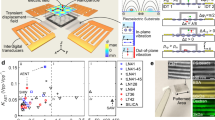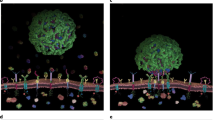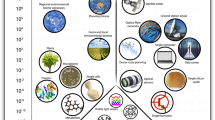Abstract
Although nanotechnology often addresses biomedical needs, nanoscale tools can also facilitate broad biological discovery. Nanoscale delivery, imaging, biosensing, and bioreactor technologies may address unmet questions at the interface between chemistry and biology. Currently, many chemical biologists do not include nanomaterials in their toolbox, and few investigators develop nanomaterials in the context of chemical tools to answer biological questions. We reason that the two fields are ripe with opportunity for greater synergy. Nanotechnologies can expand the utility of chemical tools in the hands of chemical biologists, for example, through controlled delivery of reactive and/or toxic compounds or signal-binding events of small molecules in living systems. Conversely, chemical biologists can work with nanotechnologists to address challenging biological questions that are inaccessible to both communities. This Perspective aims to introduce the chemical biology community to nanotechnologies that may expand their methodologies while inspiring nanotechnologists to address questions relevant to chemical biology.

This is a preview of subscription content, access via your institution
Access options
Access Nature and 54 other Nature Portfolio journals
Get Nature+, our best-value online-access subscription
$29.99 / 30 days
cancel any time
Subscribe to this journal
Receive 12 print issues and online access
$259.00 per year
only $21.58 per issue
Buy this article
- Purchase on Springer Link
- Instant access to full article PDF
Prices may be subject to local taxes which are calculated during checkout






Similar content being viewed by others
References
Kreyling, W. G., Semmler-Behnke, M. & Chaudhry, Q. A complementary definition of nanomaterial. Nano Today 5, 165–168 (2010).
Anselmo, A. C. & Mitragotri, S. Nanoparticles in the clinic. Bioeng. Transl. Med. 1, 10–29 (2016).
Deu, E., Verdoes, M. & Bogyo, M. New approaches for dissecting protease functions to improve probe development and drug discovery. Nat. Struct. Mol. Biol. 19, 9–16 (2012).
Shamay, Y. et al. Quantitative self-assembly prediction yields targeted nanomedicines. Nat. Mater. 17, 361–368 (2018).
Wang, A. Z., Langer, R. & Farokhzad, O. C. Nanoparticle delivery of cancer drugs. Annu. Rev. Med. 63, 185–198 (2012).
Alidori, S. et al. Targeted fibrillar nanocarbon RNAi treatment of acute kidney injury. Sci. Transl. Med. 8, 331ra339 (2016).
Bianco, A., Kostarelos, K. & Prato, M. Applications of carbon nanotubes in drug delivery. Curr. Opin. Chem. Biol. 9, 674–679 (2005).
Alexis, F., Pridgen, E. M., Langer, R. & Farokhzad, O. C. in Drug Delivery Handbook of Experimental Pharmacology vol. 197 (ed Schäfer-Korting, M.) 55–86 (Springer, Berlin, Heidelberg, 2010); https://doi.org/10.1007/978-3-642-00477-3_2
Wei, X. et al. Cardinal role of intraliposome doxorubicin-sulfate nanorod crystal in doxil properties and performance. ACS Omega 3, 2508–2517 (2018).
Govender, T., Stolnik, S., Garnett, M. C., Illum, L. & Davis, S. S. PLGA nanoparticles prepared by nanoprecipitation: drug loading and release studies of a water soluble drug. J. Control. Release 57, 171–185 (1999).
Yoo, H. S., Oh, J. E., Lee, K. H. & Park, T. G. Biodegradable nanoparticles containing doxorubicin-PLGA conjugate for sustained release. Pharm. Res. 16, 1114–1118 (1999).
Badeau, B. A., Comerford, M. P., Arakawa, C. K., Shadish, J. A. & DeForest, C. A. Engineered modular biomaterial logic gates for environmentally triggered therapeutic delivery. Nat. Chem. 10, 251–258 (2018).
Ramasamy, T. et al. Layer-by-layer assembly of liposomal nanoparticles with PEGylated polyelectrolytes enhances systemic delivery of multiple anticancer drugs. Acta Biomater. 10, 5116–5127 (2014).
Horcajada, P. et al. Porous metal-organic-framework nanoscale carriers as a potential platform for drug delivery and imaging. Nat. Mater. 9, 172–178 (2010).
El-Sayed, A., Khalil, I. A., Kogure, K., Futaki, S. & Harashima, H. Octaarginine- and octalysine-modified nanoparticles have different modes of endosomal escape. J. Biol. Chem. 283, 23450–23461 (2008).
Budhathoki-Uprety, J., Langenbacher, R. E., Jena, P. V., Roxbury, D. & Heller, D. A. A carbon nanotube optical sensor reports nuclear entry via a noncanonical pathway. ACS Nano 11, 3875–3882 (2017).
Yameen, B. et al. Insight into nanoparticle cellular uptake and intracellular targeting. J. Control. Release 190, 485–499 (2014).
Paulo, C. S., Pires das Neves, R. & Ferreira, L. S. Nanoparticles for intracellular-targeted drug delivery. Nanotechnology 22, 494002 (2011).
Lee, J. et al. Nonendocytic delivery of functional engineered nanoparticles into the cytoplasm of live cells using a novel, high-throughput microfluidic device. Nano Lett. 12, 6322–6327 (2012).
Gradishar, W. J. et al. Phase III trial of nanoparticle albumin-bound paclitaxel compared with polyethylated castor oil-based paclitaxel in women with breast cancer. J. Clin. Oncol. 23, 7794–7803 (2005).
Shamay, Y. et al. P-selectin is a nanotherapeutic delivery target in the tumor microenvironment. Sci. Transl. Med. 8, 345ra387 (2016).
Almeida, J. P. M., Chen, A. L., Foster, A. & Drezek, R. In vivo biodistribution of nanoparticles. Nanomedicine (Lond.) 6, 815–835 (2011).
Jokerst, J. V., Lobovkina, T., Zare, R. N. & Gambhir, S. S. Nanoparticle PEGylation for imaging and therapy. Nanomedicine (Lond.) 6, 715–728 (2011).
Matsumura, Y. & Maeda, H. A new concept for macromolecular therapeutics in cancer chemotherapy: mechanism of tumoritropic accumulation of proteins and the antitumor agent smancs. Cancer Res. 46, 6387–6392 (1986).
Wang, J. et al. The combined effects of size and surface chemistry on the accumulation of boronic acid-rich protein nanoparticles in tumors. Biomaterials 35, 866–878 (2014).
Prabhakar, U. et al. Challenges and key considerations of the enhanced permeability and retention effect for nanomedicine drug delivery in oncology. Cancer Res. 73, 2412–2417 (2013).
Schroeder, A. et al. Treating metastatic cancer with nanotechnology. Nat. Rev. Cancer 12, 39–50 (2011).
Burns, A. A. et al. Fluorescent silica nanoparticles with efficient urinary excretion for nanomedicine. Nano Lett. 9, 442–448 (2009).
Williams, R. M. et al. Mesoscale nanoparticles selectively target the renal proximal tubule epithelium. Nano Lett. 15, 2358–2364 (2015).
Williams, R. M. et al. Selective nanoparticle targeting of the renal tubules. Hypertension 71, 87–94 (2018).
Choi, C. H. J., Zuckerman, J. E., Webster, P. & Davis, M. E. Targeting kidney mesangium by nanoparticles of defined size. Proc. Natl. Acad. Sci. USA 108, 6656–6661 (2011).
Deshmukh, M. et al. Biodistribution and renal clearance of biocompatible lung targeted poly(ethylene glycol) (PEG) nanogel aggregates. J. Control. Release 164, 65–73 (2012).
Sharma, R., Saxena, D., Dwivedi, A. K. & Misra, A. Inhalable microparticles containing drug combinations to target alveolar macrophages for treatment of pulmonary tuberculosis. Pharm. Res. 18, 1405–1410 (2001).
Mistry, A., Stolnik, S. & Illum, L. Nanoparticles for direct nose-to-brain delivery of drugs. Int. J. Pharm. 379, 146–157 (2009).
D’Addio, S. M. & Prud’homme, R. K. Controlling drug nanoparticle formation by rapid precipitation. Adv. Drug Deliv. Rev. 63, 417–426 (2011).
Geng, Y. et al. Shape effects of filaments versus spherical particles in flow and drug delivery. Nat. Nanotechnol. 2, 249–255 (2007).
Gratton, S. E. et al. Nanofabricated particles for engineered drug therapies: a preliminary biodistribution study of PRINT nanoparticles. J. Control. Release 121, 10–18 (2007).
Wang, A. Z. et al. Biofunctionalized targeted nanoparticles for therapeutic applications. Expert Opin. Biol. Ther. 8, 1063–1070 (2008).
Silpe, J. E. et al. Avidity modulation of folate-targeted multivalent dendrimers for evaluating biophysical models of cancer targeting nanoparticles. ACS Chem. Biol. 8, 2063–2071 (2013).
Schmid, D. et al. T cell-targeting nanoparticles focus delivery of immunotherapy to improve antitumor immunity. Nat. Comm. 8, 1747 (2017).
Panyam, J. & Labhasetwar, V. Biodegradable nanoparticles for drug and gene delivery to cells and tissue. Adv. Drug Deliv. Rev. 55, 329–347 (2003).
Cheng, Q. et al. Selective organ targeting (SORT) nanoparticles for tissue-specific mRNA delivery and CRISPR-Cas gene editing. Nat. Nanotechnol. 15, 313–320 (2020).
Adams, D. et al. Patisiran, an RNAi therapeutic, for hereditary transthyretin amyloidosis. N. Engl. J. Med. 379, 11–21 (2018).
Yusop, R. M., Unciti-Broceta, A., Johansson, E. M., Sánchez-Martín, R. M. & Bradley, M. Palladium-mediated intracellular chemistry. Nat. Chem. 3, 239–243 (2011).
Tonga, G. Y. et al. Supramolecular regulation of bioorthogonal catalysis in cells using nanoparticle-embedded transition metal catalysts. Nat. Chem. 7, 597–603 (2015).
Islam, M. A. et al. Restoration of tumour-growth suppression in vivo via systemic nanoparticle-mediated delivery of PTEN mRNA. Nat. Biomed. Eng. 2, 850–864 (2018).
Xie, R., Hong, S., Feng, L., Rong, J. & Chen, X. Cell-selective metabolic glycan labeling based on ligand-targeted liposomes. J. Am. Chem. Soc. 134, 9914–9917 (2012).
Sun, Y. et al. Mechanistic investigation and multiplexing of liposome-assisted metabolic glycan labeling. J. Am. Chem. Soc. 140, 3592–3602 (2018).
Crespilho, F. N., Iost, R. M., Travain, S. A., Oliveira, O. N. Jr. & Zucolotto, V. Enzyme immobilization on Ag nanoparticles/polyaniline nanocomposites. Biosens. Bioelectron. 24, 3073–3077 (2009).
Choi, H.-J. & Montemagno, C. D. Artificial organelle: ATP synthesis from cellular mimetic polymersomes. Nano Lett. 5, 2538–2542 (2005).
Kudina, O. et al. Highly efficient phase boundary biocatalysis with enzymogel nanoparticles. Angew. Chem. Int. Edn Engl. 53, 483–487 (2014).
Lian, X., Erazo-Oliveras, A., Pellois, J. P. & Zhou, H. C. High efficiency and long-term intracellular activity of an enzymatic nanofactory based on metal-organic frameworks. Nat. Commun. 8, 2075 (2017).
Jordan, P. C. et al. Self-assembling biomolecular catalysts for hydrogen production. Nat. Chem. 8, 179–185 (2016).
Wijnands, S. P. W., Engelen, W., Lafleur, R. P. M., Meijer, E. W. & Merkx, M. Controlling protein activity by dynamic recruitment on a supramolecular polymer platform. Nat. Commun. 9, 65 (2018).
Ke, G. et al. Directional regulation of enzyme pathways through the control of substrate channeling on a DNA origami scaffold. Angew. Chem. Int. Edn Engl. 55, 7483–7486 (2016).
Jiang, D. et al. Nanozyme: new horizons for responsive biomedical applications. Chem. Soc. Rev. 48, 3683–3704 (2019).
Dong, H., Fan, Y., Zhang, W., Gu, N. & Zhang, Y. Catalytic mechanisms of nanozymes and their applications in biomedicine. Bioconjug. Chem. 30, 1273–1296 (2019).
Park, S. M., Aalipour, A., Vermesh, O., Yu, J. H. & Gambhir, S. S. Towards clinically translatable in vivo nanodiagnostics. Nat. Rev. Mater. 2, 17014 (2017).
Benezra, M. et al. Multimodal silica nanoparticles are effective cancer-targeted probes in a model of human melanoma. J. Clin. Invest. 121, 2768–2780 (2011).
Chen, M. J. & Yin, M. Z. Design and development of fluorescent nanostructures for bioimaging. Prog. Polym. Sci. 39, 365–395 (2014).
Medintz, I. L., Uyeda, H. T., Goldman, E. R. & Mattoussi, H. Quantum dot bioconjugates for imaging, labelling and sensing. Nat. Mater. 4, 435–446 (2005).
Michalet, X. et al. Quantum dots for live cells, in vivo imaging, and diagnostics. Science 307, 538–544 (2005).
Heller, D. A., Baik, S., Eurell, T. E. & Strano, M. S. Single‐walled carbon nanotube spectroscopy in live cells: towards long‐term labels and optical sensors. Adv. Mater. 17, 2793–2799 (2005).
O’Connell, M. J. et al. Band gap fluorescence from individual single-walled carbon nanotubes. Science 297, 593–596 (2002).
Wen, J., Xu, Y., Li, H., Lu, A. & Sun, S. Recent applications of carbon nanomaterials in fluorescence biosensing and bioimaging. Chem. Commun. (Camb.) 51, 11346–11358 (2015).
Ghosh, D. et al. Deep, noninvasive imaging and surgical guidance of submillimeter tumors using targeted M13-stabilized single-walled carbon nanotubes. Proc. Natl. Acad. Sci. USA 111, 13948–13953 (2014).
Godin, A. G. et al. Single-nanotube tracking reveals the nanoscale organization of the extracellular space in the live brain. Nat. Nanotechnol. 12, 238–243 (2017).
Lim, S. Y., Shen, W. & Gao, Z. Carbon quantum dots and their applications. Chem. Soc. Rev. 44, 362–381 (2015).
Hemelaar, S. R. et al. Nanodiamonds as multi-purpose labels for microscopy. Sci. Rep. 7, 720 (2017).
Fox, M. D. & Raichle, M. E. Spontaneous fluctuations in brain activity observed with functional magnetic resonance imaging. Nat. Rev. Neurosci. 8, 700–711 (2007).
Estelrich, J., Sánchez-Martín, M. J. & Busquets, M. A. Nanoparticles in magnetic resonance imaging: from simple to dual contrast agents. Int. J. Nanomedicine 10, 1727–1741 (2015).
Thakor, A. S. et al. Clinically approved nanoparticle imaging agents. J. Nucl. Med. 57, 1833–1837 (2016).
Popovtzer, R. et al. Targeted gold nanoparticles enable molecular CT imaging of cancer. Nano Lett. 8, 4593–4596 (2008).
Pérez-Medina, C. et al. A modular labeling strategy for in vivo PET and near-infrared fluorescence imaging of nanoparticle tumor targeting. J. Nucl. Med. 55, 1706–1711 (2014).
Xie, J. et al. PET/NIRF/MRI triple functional iron oxide nanoparticles. Biomaterials 31, 3016–3022 (2010).
Lei, J. & Ju, H. Signal amplification using functional nanomaterials for biosensing. Chem. Soc. Rev. 41, 2122–2134 (2012).
Liu, Z. et al. Multiplexed five-color molecular imaging of cancer cells and tumor tissues with carbon nanotube raman tags in the near-infrared. Nano Res. 3, 222–233 (2010).
Li, Y., Wang, Z., Mu, X., Ma, A. & Guo, S. Raman tags: novel optical probes for intracellular sensing and imaging. Biotechnol. Adv. 35, 168–177 (2017).
Li, S. et al. Dual-mode ultrasensitive quantification of microRNA in living cells by chiroplasmonic nanopyramids self-assembled from gold and upconversion nanoparticles. J. Am. Chem. Soc. 138, 306–312 (2016).
Maxwell, D. J., Taylor, J. R. & Nie, S. Self-assembled nanoparticle probes for recognition and detection of biomolecules. J. Am. Chem. Soc. 124, 9606–9612 (2002).
Gao, Y., Shi, J., Yuan, D. & Xu, B. Imaging enzyme-triggered self-assembly of small molecules inside live cells. Nat. Commun. 3, 1033 (2012).
Mu, C. J., Lavan, D. A., Langer, R. S. & Zetter, B. R. Self-assembled gold nanoparticle molecular probes for detecting proteolytic activity in vivo. ACS Nano 4, 1511–1520 (2010).
Ling, D. et al. Multifunctional tumor pH-sensitive self-assembled nanoparticles for bimodal imaging and treatment of resistant heterogeneous tumors. J. Am. Chem. Soc. 136, 5647–5655 (2014).
Kruss, S. et al. High-resolution imaging of cellular dopamine efflux using a fluorescent nanosensor array. Proc. Natl. Acad. Sci. USA 114, 1789–1794 (2017).
Beyene, A. G. et al. Imaging striatal dopamine release using a nongenetically encoded near infrared fluorescent catecholamine nanosensor. Sci. Adv. 5, eaaw3108 (2019).
Williams, R. M., Lee, C. & Heller, D. A. A fluorescent carbon nanotube sensor detects the metastatic prostate cancer biomarker uPA. ACS Sens. 3, 1838–1845 (2018).
Chang, H., Tang, L., Wang, Y., Jiang, J. & Li, J. Graphene fluorescence resonance energy transfer aptasensor for the thrombin detection. Anal. Chem. 82, 2341–2346 (2010).
Rasheed, P. A. & Sandhyarani, N. Carbon nanostructures as immobilization platform for DNA: a review on current progress in electrochemical DNA sensors. Biosens. Bioelectron. 97, 226–237 (2017).
Hahm, J.-i & Lieber, C. M. Direct ultrasensitive electrical detection of DNA and DNA sequence variations using nanowire nanosensors. Nano Lett. 4, 51–54 (2004).
Feng, L., Chen, Y., Ren, J. & Qu, X. A graphene functionalized electrochemical aptasensor for selective label-free detection of cancer cells. Biomaterials 32, 2930–2937 (2011).
Jena, P. V. et al. A carbon nanotube optical reporter maps endolysosomal lipid flux. ACS Nano 11, 10689–10703 (2017).
Galassi, T. V. et al. An optical nanoreporter of endolysosomal lipid accumulation reveals enduring effects of diet on hepatic macrophages in vivo. Sci. Transl. Med. 10, eaar2680 (2018).
Harvey, J. D. et al. A carbon nanotube reporter of microRNA hybridization events in vivo. Nat. Biomed. Eng. 1, 0041 (2017).
Iverson, N. M. et al. In vivo biosensing via tissue-localizable near-infrared-fluorescent single-walled carbon nanotubes. Nat. Nanotechnol. 8, 873–880 (2013).
Williams, R. M. et al. Noninvasive ovarian cancer biomarker detection via an optical nanosensor implant. Sci. Adv. 4, eaaq1090 (2018).
Chang, P. V. et al. Copper-free click chemistry in living animals. Proc. Natl. Acad. Sci. USA 107, 1821–1826 (2010).
Li, J., Jia, S. & Chen, P. R. Diels-Alder reaction-triggered bioorthogonal protein decaging in living cells. Nat. Chem. Biol. 10, 1003–1005 (2014).
Roxbury, D. et al. Hyperspectral microscopy of near-infrared fluorescence enables 17-chirality carbon nanotube imaging. Sci. Rep. 5, 14167 (2015).
Acknowledgements
This work was supported in part by the Cancer Center Support Grant (D.A.H., M.L.: P30-CA008748), the NIH New Innovator Award (D.A.H.: DP2-HD075698), National Institute of Diabetes and Digestive and Kidney Diseases (D.A.H.: R01-DK114321), National Cancer Institute (D.A.H.: R01-CA215719), National Institute of Neurological Disorders and Stroke (D.A.H.: R01-NS116353), Clinical and Translational Science Center Grant (D.A.H.: UL1-TR002384), National Institute of General Medical Sciences (M.L.: R01GM096056, R01GM120570, R35GM134878), the National Science Foundation CAREER Award (D.A.H: 1752506), the American Cancer Society Research Scholar Grant (D.A.H.: GC230452), Mr. William H. Goodwin and Mrs. Alice Goodwin and the Commonwealth Foundation for Cancer Research, the Experimental Therapeutics Center (D.A.H., M.L.), the Pershing Square Sohn Cancer Research Alliance (D.A.H.), the Honorable Tina Brozman Foundation for Ovarian Cancer Research (D.A.H.), the Expect Miracles Foundation – Financial Services Against Cancer (D.A.H.), the Anna Fuller Fund (D.A.H.), the Louis V. Gerstner Jr. Young Investigator’s Fund (D.A.H.), the Frank A. Howard Scholars Program (D.A.H.), Cycle for Survival (D.A.H.), the Alan and Sandra Gerry Metastasis Research Initiative (D.A.H.), the Imaging & Radiation Sciences Program (D.A.H.), and the Center for Molecular Imaging and Nanotechnology of Memorial Sloan Kettering Cancer (D.A.H.), Starr Cancer Consortium (M.L.), Functional Genomic Initiative (M.L.), the Alan and Sandra Gerry Metastasis and Tumor Ecosystems Center (M.L.), Tri-institute Program of Chemical Biology (S.C.). R.M.W. was supported by the City College of New York Grove School of Engineering, the Ovarian Cancer Research Fund (Ann Schreiber Mentored Investigator Award 370463), and the American Heart Association Postdoctoral Fellowship (17POST33650043).
Author information
Authors and Affiliations
Contributions
R.M.W., S.C., J.B.U., M.L., and D.A.H. conceived of the manuscript; all authors reviewed the literature and drafted the manuscript.
Corresponding authors
Ethics declarations
Competing interests
D.A.H. is a cofounder and officer with equity interest in Goldilocks Therapeutics, Inc., LipidSense, Inc., and Nirova BioSense, Inc. D.A.H. is a member of the scientific advisory boards of Concarlo Holdings, LLC and Nanorobotics, Inc. R.M.W. is a scientific advisor with equity interest in Goldilocks Therapeutics, Inc. M.L. is a member of the scientific advisory board of Epi One, Inc. P.V.J. is a cofounder and officer with equity interest in LipidSense, Inc. and an officer of Nirova BioSense, Inc.
Additional information
Publisher’s note Springer Nature remains neutral with regard to jurisdictional claims in published maps and institutional affiliations.
Rights and permissions
About this article
Cite this article
Williams, R.M., Chen, S., Langenbacher, R.E. et al. Harnessing nanotechnology to expand the toolbox of chemical biology. Nat Chem Biol 17, 129–137 (2021). https://doi.org/10.1038/s41589-020-00690-6
Received:
Accepted:
Published:
Issue Date:
DOI: https://doi.org/10.1038/s41589-020-00690-6
This article is cited by
-
Advances of medical nanorobots for future cancer treatments
Journal of Hematology & Oncology (2023)
-
Nanosensor-based monitoring of autophagy-associated lysosomal acidification in vivo
Nature Chemical Biology (2023)
-
Coordination-driven self-assembly of metallo-nanodrugs for local inflammation alleviation
Nano Research (2023)
-
Environmental dimensions of the protein corona
Nature Nanotechnology (2021)



